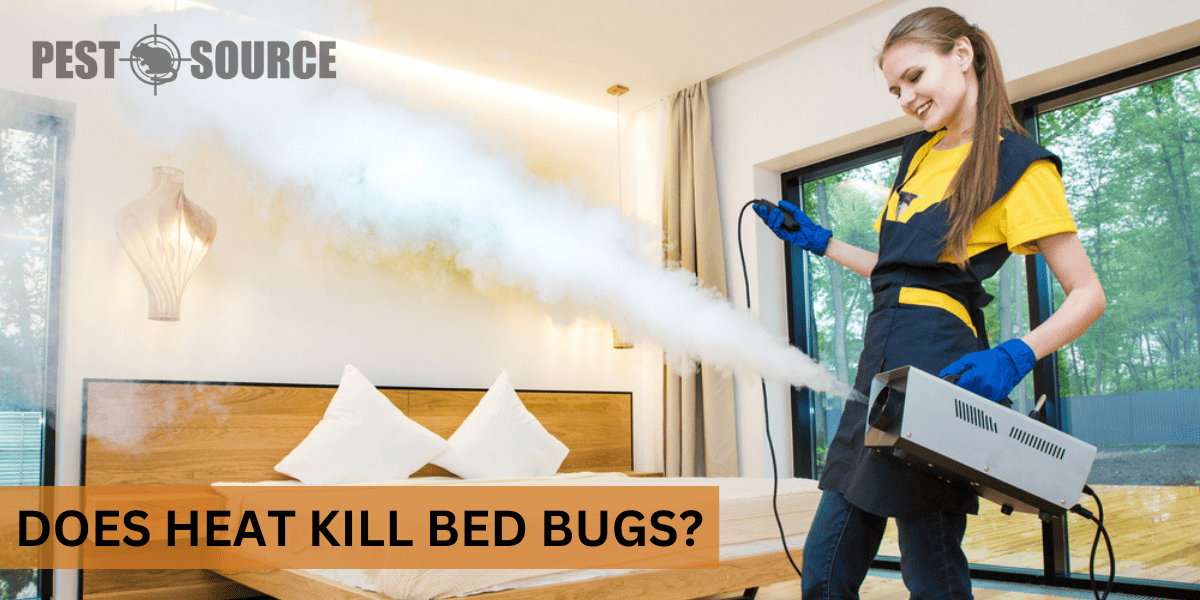Heat is an effective method for killing bed bugs, with temperatures above 120°F (49°C) proven lethal to all life stages. Professional heat treatments raise room temperatures to this level to ensure thorough eradication. This post will discuss how heat treatments work, their advantages, and considerations to keep in mind when using heat as a bed bug control method.
POINTS
- Heat treatment is an effective method to eradicate bed bugs at all life stages, even eggs. To be effective, it requires maintaining a consistent temperature of around 120°F (49°C), effectively disrupting the essential physiological processes of these pests.
- Heat treatment can be conducted through different methods such as whole-home heat treatment, portable heaters, and steam cleaning. Each method has its own strengths, yet all aim to raise temperatures to lethal levels for bed bugs.
- While heat treatment is generally safe for humans and pets, and does not introduce harmful chemicals into the home, all living beings and sensitive items should be removed during treatment.
- Even though heat treatment can kill a large portion of a bed bug infestation, it may not reach deeply hidden or isolated bugs. In some cases, it may be necessary to combine heat treatment with other pest control measures like pesticide application or regular cleaning.
- Seeking advice from a pest control professional is crucial when dealing with a bed bug infestation and considering heat treatment. These professionals have the necessary knowledge and tools to carry out effective and safe heat treatment, ensuring all affected areas are targeted and future infestations are prevented.
Can Heat Kill Bed Bugs?
Does heat have the capacity to kill bed bugs?
Yes, heat has the ability to kill bed bugs. They are ectothermic creatures, meaning they rely on their environment to maintain their body temperature. When exposed to extreme heat, their metabolic processes fail, leading to their demise.
Why do bed bugs die in heat?
Heat disrupts the bed bug’s body systems, effectively causing it to overheat and die. Their proteins start to denature and their cell membranes get destroyed, eventually leading to dehydration and fatal loss of bodily functions.
The Science of Heat Treatment: Understanding How Heat Kills Bed Bugs
Why are bed bugs vulnerable to high temperatures?
Bed bugs are vulnerable to high temperatures because, as ectotherms, they’re unable to regulate their own body temperature. Their survival depends on the surrounding temperatures. Therefore, an environment that’s too hot will disrupt their physiological processes.
How do bed bugs regulate their body temperature?
Unlike mammals that regulate their internal body temperature, bed bugs rely on the environmental temperature to maintain their body temperature—simply put, if it’s warm, they are warm; if it’s cool, they are cool.
At what temperature do bed bugs die?
Adult bed bugs can be killed by heat exposures that reach a core temperature of 115°F (46°C) for a consistent period of 90 minutes or more. However, cooler temperatures or less time may not offer the same lethal effect.
What temperature kills bed bugs instantly?
Instant death for these bugs can be achieved at a more extreme temperature. Exposing bed bugs to heat levels of 122°F (50°C) can kill them in a matter of minutes.
What temperature kills bed bugs and their eggs?
While adults and nymph-stage bed bugs succumb at temperatures upward of 115°F (46°C), eggs are a bit more hardy. To ensure the heat treatment targets the eggs as well, the temperature should be increased to around 120°F (49°C).
Will 100 degrees kill bed bugs?
A consistent temperature of 100 degrees Fahrenheit may not be enough to kill all bed bugs, especially the eggs. More intense heat is usually required for a comprehensive elimination of these pests.
How long should the heat exposure last to ensure bed bug death?
Although a core temperature of 115°F (46°C) can kill adult bed bugs, it only works if sustained for around 90 minutes. Lower temperatures may require longer exposure times to reach the same effect. Short-term exposure to these temperatures will not ensure the comprehensive extermination of the bed bugs.
The Heat Treatment Methods: What Techniques Are Used to Apply Heat to Kill Bed Bugs?
Heat treatment against bed bugs is done in several ways. While all methods aim to raise the temperature to lethal levels, they differ in approach and application.
What are the different methods of heat treatment for bed bugs?
There are three main techniques used to utilize heat against bed bugs:
- Whole-home heat treatment: This involves raising the temperature of an entire infested house to lethal levels. Getting rid of the bugs from every part of the home, including furniture and cracks in walls.
- Portable heaters: These are used to target specific spaces or items in your home, like a single room or a piece of furniture.
- Steam cleaning: The technique uses steam to clean and sanitize areas infested with bed bugs.
What is whole-home heat treatment and how does it work?
Whole-home heat treatment, as the name suggests, treats your entire home by raising the temperature to a point that is lethal for bed bugs. Professionals use industrial heaters to raise and maintain your home’s temperature at about 120°F (49°C) for a couple of hours. This method is effective because it kills all stages of bed bugs, from eggs to adults. More on how bed bug fumigation works.
How do portable heaters work for bed bug treatment?
Portable heaters, or heat chambers, are tools that allow you to focus on specific areas, like rooms or even specific furniture. You place the infested object in the heat chamber and then raise the temperature to lethal levels for bed bugs. This spot treatment helps to tackle the problem without heating your entire home.
How is steam cleaning used in heat treatment?
Steam cleaning kills bed bugs by exposing them to lethal temperatures. It’s a good option for items like mattresses, upholstered furniture, and carpets that can withstand moisture. It kills the bugs and their eggs on contact.
How much heat is required to kill bed bugs?
The heat should be intense enough to kill all stages of the bed bug’s life cycle. That means the temperature needs to reach at least 120°F (49°C) for a successful extermination.
Effectiveness and Limitations of Heat Treatment: Does Heat Kill All Bed Bugs?
Does heat treatment always kill all the bed bugs?
While a properly performed heat treatment can eliminate a majority of bed bugs in the treated area, it may not always eliminate 100% of them. For example, bugs that have crawled into deep crevices or insulation may avoid the lethal heat.
Why might heat treatment fail to eradicate all bed bugs?
Heat treatment might fail if it does not reach all infested areas consistently, or if the temperature does not reach the necessary level, and stay there long enough, to kill all stages of the bed bug life cycle.
Can heat treatment kill bed bug eggs?
Yes, heat treatment can kill bed bug eggs, but it requires higher temperatures—around 120°F (49°C)—to be effective.
What are some limitations of using heat treatment?
While effective, heat treatment has some limitations. It can be expensive, require professional assistance, and may potentially damage certain items if not properly performed. It’s also important to remember that while the heat treatment kills the existing bugs, it does nothing to prevent a future infestation.
Understanding these details will help you decide if heat treatment is the right choice for your bed bug problem.
Heat Treatment Safety and Human Interaction: Is Heat Treatment Safe for Humans and Pets?
When faced with a bed bug infestation, it’s important to consider the safety of the pest control methods chosen. Let’s see how safe heat treatment is for humans and our furry friends.
Is heat treatment safe for humans and pets?
Yes, when executed properly, heat treatment is considered safe for both humans and pets. The treatment doesn’t involve any harsh chemicals, and once concluded, people and pets can safely return to their home. However, during treatment, it’s strongly advised that all living beings, plants, and sensitive items, such as electronics, be removed from the premises.
Do bed bugs like heat or do they prefer cooler environments?
Bed bugs prefer average room temperatures—around 70°F to 80°F (21°C to 27°C). At these temperatures, they can comfortably feed and reproduce. Extreme heat, like the temperatures used in heat treatments, is lethal to them and certainly not preferable.
Combination of Heat Treatment with Other Methods: When is it Necessary to Combine Heat Treatment with Other Bed Bug Control Methods?
Heat treatment can be exceptionally effective in killing bed bugs. However, in some cases, it may not be sufficient on its own and may need to be supplemented with other treatments.
When might it be necessary to combine heat treatment with other bed bug control methods?
If an infestation is extensive or has spread to hard-to-reach areas, heat treatment alone might not be sufficient. In such cases, it could be necessary to combine heat treatment with other methods such as pesticide application or thorough cleaning.
Why is it sometimes necessary to use methods other than heat to kill bed bugs?
While heat can be deadly to bed bugs, it can’t prevent future infestations. So, other methods like regular inspection, proper sanitation, and careful prevention can be necessary to ensure they do not return.
Why is it Important to Consult a Pest Control Professional?
Confronting a bed bug infestation can be overwhelming, especially given the nuance involved in effective treatment. This is where professional insights can guide the way.
Why should you consult with a pest control professional when considering heat treatment for bed bugs?
Pest control professionals provide valuable expertise when dealing with bed bugs. They can assess your situation, suggest the best combination of treatments, ensure those treatments are correctly implemented, and provide ongoing guidance to prevent future outbreaks.
How can pest control professionals help in determining the most effective and safe method of heat treatment?
Pest control professionals understand how to safely set up and monitor heat treatment to ensure it is effective, safe and doesn’t damage your property or belongings. They use specialized equipment, follow industry standards for safety, and have the experience to make sure the job is done right. Their customized advice leads to the best possible outcome in your fight against bed bugs.
Does cold kill Bed bugs?
Heat is not the only temperature extreme that can affect these pests. The question of does cold kill bed bugs is also worth exploring. Cold temperatures can also be detrimental to bed bugs, but the effectiveness of this method depends on several factors. It’s essential to understand the conditions under which cold becomes a viable solution against these unwelcome guests.



